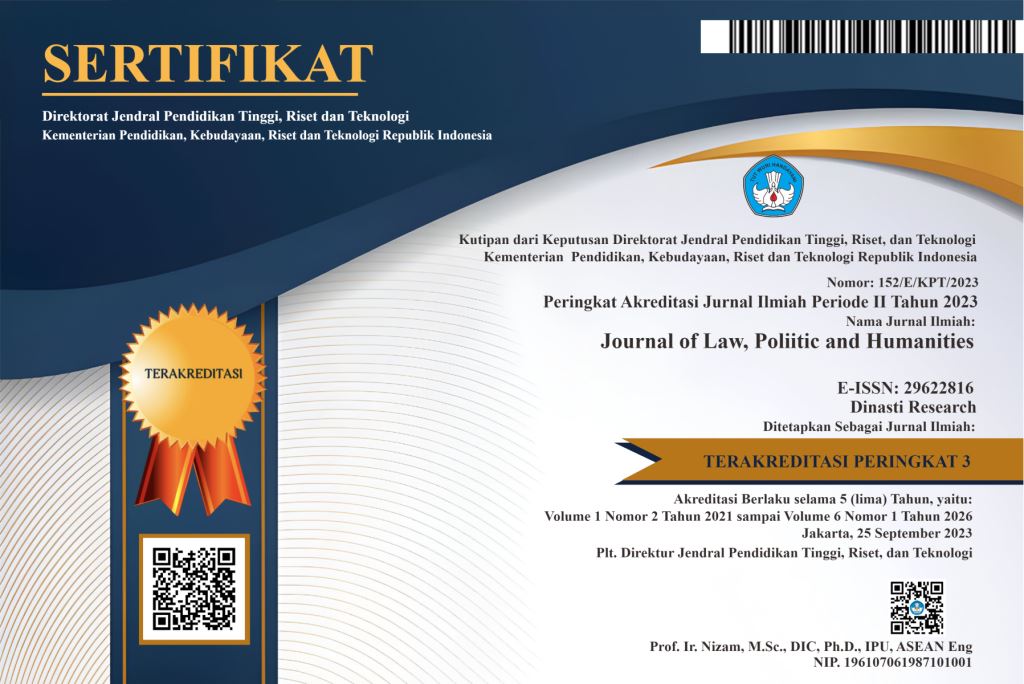Improving Employee Performance Through Motivation and Work Discipline
DOI:
https://doi.org/10.38035/jlph.v3i2.183Keywords:
Motivation, Dicipline, PerformanceAbstract
This study looked at the relationship between performance and motivation and discipline at Radjak Hospital Salemba. This study used quantitative data collected through a Likert scale with the SPSS version 23 program. Data were collected from 221 patients at Radjak Hospital Salemba. This hospital is located in the northwestern part of Indonesia and is staffed by local residents. This research uses quantitative descriptive research. A population of 221 people was tested using the Slovin sample formula, and at least 69 people were included in the sample. The results are positive, with a Sig Value of 0.259 and a T-Test Result of 0.040. Additionally, 3. Based on the results of multiple linear regression, work motivation and work discipline have a positive effect on employee performance. This influence can be seen in the constant values ??of 0.797 and 0.259 for positive work motivation and work discipline, respectively. In addition, the Sig T test shows that the two characteristics of work ethics have a significant effect on employee performance with values ??of 0.040 and 0.000 respectively. Work motivation and discipline also affect employee performance by 69.4% which is explained from the results of the R square test. The remaining 30.6% due to this influence is caused by other factors not examined in this study.
References
A.A. Anwar Prabu Mangkunegara. 2017. Manajemen Sumber Daya Manusia Perusahaan, Bandung Remaja Rosdakarya.
Bohlander, George., and Snell, Scott. (2010). Principles of Human Resource. Management, 15th ed. Mason, OH: South Western – Cengage Learning
Buchari, Zainun.2001, Manajemen Sumber Daya Manusia Indonesia, Penerbit Gunung Agung, Jakarta.
Dessler, G. (2015). Manajemen Sumber Daya Manusia. Jakarta: Salemba Empat.
Dessler, Gary. 2016. Manajemen Sumber Daya Manusia, Jilid 1 Edisi 10, Alih Bahasa : Paramita Rahay, (2016), Indeks, Jakarta.
Edison, Emron., dkk. 2016 Manajemen Sumber Daya Manusia. Alfabeta. Bandung
Edy, Sutrisno, (2016), Manajemen Sumber Daya Manusia, Kencana Prenada Media Group, Jakarta.
Ghozali, Imam. 2018. Aplikasi Analisis Multivariate dengan Program IBM SPSS 25. Badan Penerbit Universitas Diponegoro: Semarang
Gomes, Faustino Cardoso. 1997. Manajemen Sumber Daya Manusia. Yogyakarta: Andi Offset
Gordon, Thomas. 1996. Mengajar Anak Berdisiplin Diri di Rumah dan di Sekolah. Jakarta: PT Gramedia Pustaka Utama
Hasibuan, M. 2003. Organisasi dan Motivasi Dasar Peningkatan Produktivitas. Jakarta: Bumi Aksara
Henry Simamora. 2000. Basis Pengambilan Keputusan Bisnis. Salemba Empat. Jakarta.
Hawari, D. (2016). Manajemen Stres Cemas dan Depresi. Jakarta: Fakultas Kedokteran Universitas Indonesia.
Indah Puji Hartatik SE, M.M. buku praktis mengembangkan SDM. Yogyakarta: Laksana; 2014.
Limakrisna, N., Noor, Z. Z., & Ali, H. (2016). Model of employee performance: The empirical study at civil servants in government of west java province. International Journal of Economic Research.
Luthans, Fred., (2011), Perilaku Organisasi, (Alih Bahasa V.A Yuwono, dkk), Edisi, Bahasa Indonesia, Jakarta, PT Indek.
Kasmir. 2019. Manajemen Sumber Daya manusia. Depok: Rajawali. Pers.
Maryatmi, A. S., & Limakrisna, N. (2020). Job satisfaction as a mediator of career development and job security for well-being. International Journal of Innovation, Creativity and Change.
Mathis, R.L. & J.H. Jackson. 2006. Human Resource Management: Manajemen Sumber Daya Manusia. Terjemahan Dian Angelia. Jakarta: Salemba Empat.
Michael, Amstrong, 2006. A Handbook of Human Resource Management Practice Edition. London: Kogan Page
Miner, John. 1998. Organizational Behavior, Performance and Productivity. New York: Random House Business Division.
Mondy R Wayne. 2008. Manajemen Sumber Daya Manusia. Jakarta: Erlangga
Mahsun. M. 2006. Pengukuran Kinerja Sector Public. BPFE: Yogyakarta
Putra, R. A., Candana, D. M., & Krisna, N. L. (2020). THE EFFECT OF CAREER DEVELOPMENT AND ORGANIZATIONAL COMMITMENT TO EMPLOYEE PERFORMANCE WITH JOB SATISFACTION AS A …. Dinasti International Journal of Management.
Rivai, Veithzal. 2004.Manajemen Sumber Daya Manusia Untuk Perusahaan. Jakarta: Grafindo.
Sugiyono. 2018. Metode Penelitian Kuantitatif, Kualitatif, dan R&D. Bandung: Alfabeta
Robbins, Stephen P. 2005. Perilaku Organisasi. Jakarta: Indeks
Santoso, Singgih. 2012. Statistik Parametik. Jakarta: PT Gramedia Pustaka Umum.
Sedarmayanti. 2007. Manajemen Sumber Daya Manusia. Refika Aditama, Bandung
Siagian, Sondang P, 2004, Teori Motivasi Dan Aplikasinya,Bina Aksara Jakarta
Siagian, Sondang P. 2003. Teori & praktek kepemimpinan. Jakarta: Rineka Cipta.
Schultz, D., Schultz, S E. 2006. Psychology & Work Today Ninth Edition. New Jersey: Pearson Education. Inc
Downloads
Published
How to Cite
Issue
Section
License
Authors who publish their manuscripts in this journal agree to the following conditions:
- The copyright on each article belongs to the author(s).
- The author acknowledges that the Journal of Law, Poliitic and Humanities (JLPH) has the right to be the first to publish with a Creative Commons Attribution 4.0 International license (Attribution 4.0 International (CC BY 4.0).
- Authors can submit articles separately, arrange for the non-exclusive distribution of manuscripts that have been published in this journal into other versions (e.g., sent to the author's institutional repository, publication into books, etc.), by acknowledging that the manuscript has been published for the first time in the Journal of Law, Poliitic and Humanities (JLPH).


























